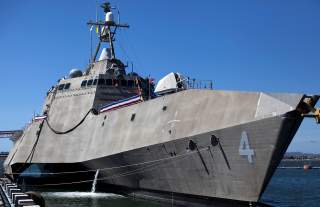Shocker. The U.S. Navy Won’t Grow to 355 Ships, After All
In a move that should surprise no one, the U.S. Navy has begun walking back its plan to expand its front-line fleet from today’s 290 vessels to 355 sometime in the 2030s.
In a move that should surprise no one, the U.S. Navy has begun walking back its plan to expand its front-line fleet from today’s 290 vessels to 355 sometime in the 2030s.
Experts long had anticipated the reversal in policy.
Top Navy leaders cited in their decision the high cost of the bigger fleet as well as the accelerating plan to add robotic vessels to the fleet. Under current conventions, the unmanned ships might not count in the Navy’s tally of “battle force” ships.
“Will we get to 355-ships?” Vice Chief of Naval Operations Adm. Robert Burke said on Oct. 25, 2019. “I think with today’s fiscal situation, where the Navy’s top line is right now, we can keep around 305 to 310 ships whole, properly manned, properly maintained, properly equipped and properly ready.”
The administration of former president Barack Obama in late 2016 first announced a plan to grow the fleet to 350 ships. Pres. Donald Trump campaigned on a pledge to expand the battle force to 355 ships. The Navy as recently as early 2019 projected it could grow to 355 front-line vessels by 2034.
But the Navy anticipated it would need around $25 billion a year every year through 2049 just for new ships. That's roughly double what the service historically has spent.
The Trump administration has added billions of dollars to the Department of the Navy’s roughly $200-billion annual budget. But the administration’s tax cuts have resulted in trillion-dollar annual federal budget deficits. And Trump’s various trade wars have cut into the United States’ economic growth.
The Navy seems to recognize that it probably will not be getting more money than it already gets. Instead of 355 ships, the service announced it should try to expand to a high of 314 ships by 2024.
“If our top line does not go up, if it remains where it is now and is projected to remain in the future defense plans, that’s about where we can get to and do it right, in terms of man those ships and maintain them and have all the ordnance for them and generate readiness,” Burke said.
Experts years ago predicted the lower force-structure goal. One Congressional shipbuilding expert told The National Interest, on condition of anonymity, that quickly growing the Navy by 75 ships simply by buying new vessels "would be impossible" owing to the cost of buying, manning and maintaining the vessels.
But money isn’t the only factor in the Navy’s plan for more modestly expanding fleet. Increasingly, experts and Navy officials want the fleet to add large numbers of expendable robotic vessels in order to prepare for potentially bloody fleet-on-fleet battles with the Russian or Chinese navies.
The Navy in its 2020 budget request asked Congress for the first installment on a $4-billion acquisition of 10 large unmanned surface vessels and nine unmanned submarines. Boeing is developing the robotic submarines, using its 51-feet-long Orca submersible as a starting point.
The sailing branch hasn’t yet selected a shipyard to build the unmanned surface vessels. The USVs could be similar to the Sea Hunter robot ship that the Navy has been testing since 2016. Sea Hunter is 132 feet long.
A USV similar to Sea Hunter could carry scores of missiles cells while still costing just a few tens of millions of dollars. A manned Navy vessel on average costs $2 billion. Missile-hauling USVs cheaply could add firepower to Navy battle groups and help to replace the Navy’s four aging cruise-missile submarines, or SSGNs.
“I think this is going to one of the main things driving the design of the large unmanned surface combatant,” Dan Gouré, an analyst at the Lexington Institute think tank, told Defense News.
The concept invokes a defunct Navy program from the 1990s that would have added hundreds of missile cells to an inexpensive manned “arsenal ship.” “We’re back to arsenal ship,” Gouré said. “Long-range, park it into a surface action group of carrier strike group — kind of like a surface version of the SSGN.”
But the catch is that the Navy probably wouldn’t count the USVs as battle-force vessels, much in the way it also doesn’t count support ships, small patrol boats and minehunters.
If the Navy indeed does invest heavily in large numbers of robotic vessels, it could expand the fleet without requiring a big budget boost. That expansion, however, wouldn’t be obvious on paper.
David Axe serves as Defense Editor of the National Interest. He is the author of the graphic novels War Fix, War Is Boring and Machete Squad.

